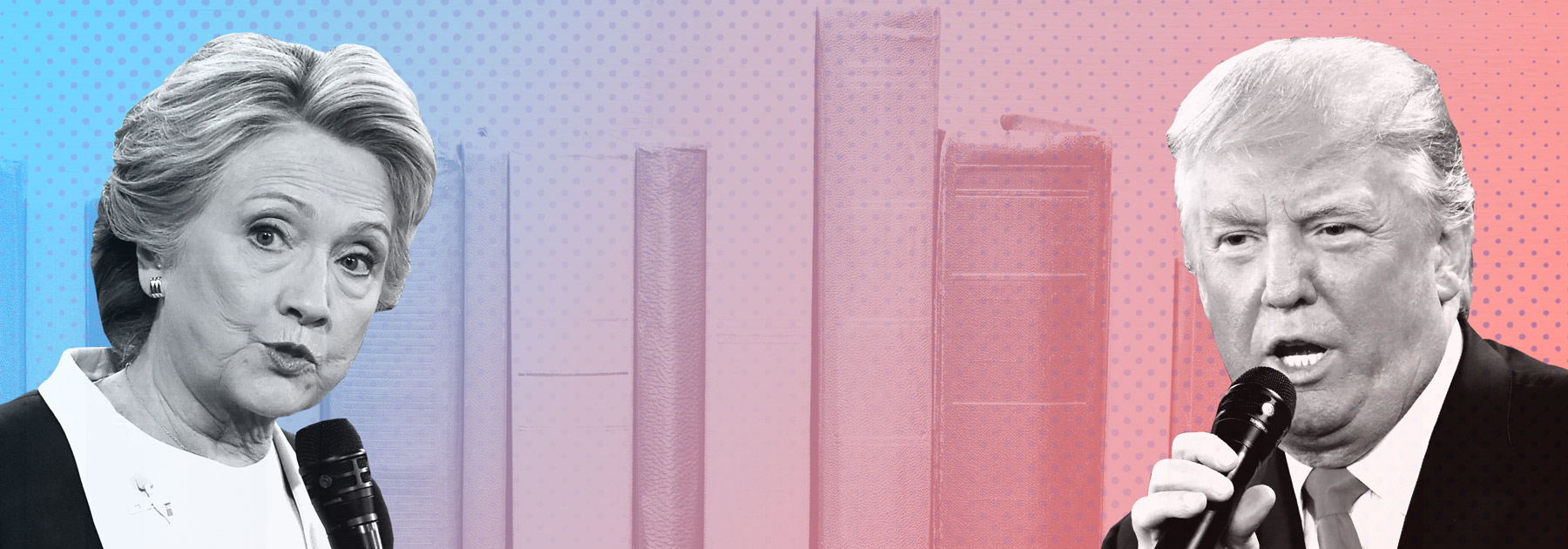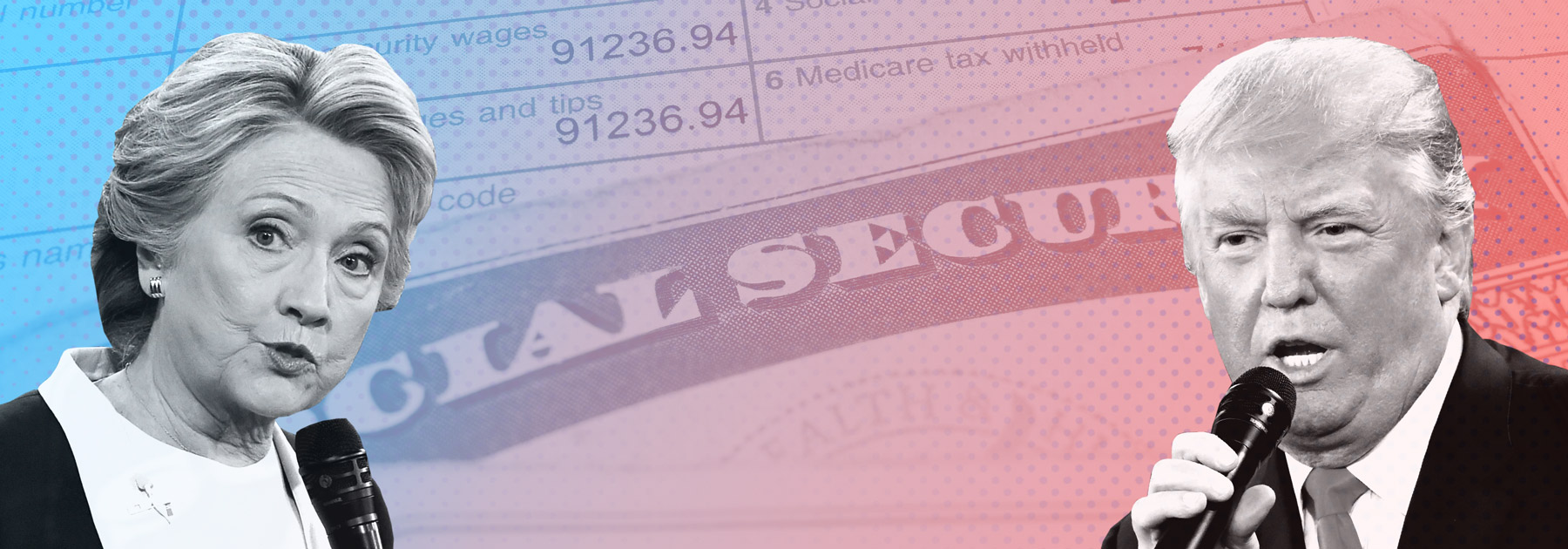Clinton, Trump … and your cash
A last-minute cheat sheet to where the candidates stand on taxes, child care costs, Social Security and more
Use the icons below to select and compare





Income taxes Dependent care Health costs College Social Security
What they'll do to your tax bill
Clinton
Raise taxes on the top 1% by:
— Imposing the “Buffett Rule,” which requires those with adjusted gross incomes over $2 million to pay a minimum of 30% of their income in federal taxes.
— Adding a 4% surcharge for those who make more than $5 million.
— Increasing the rates investors pay in capital gains for investments held less than 6 years.
— Increasing the estate tax rate to between 45% and 65%, depending on size of estate. And reducing to $3.5 million how much money is exempt from the estate tax.
Low-and middle-income households would see a small tax cut on average.*
Trump
Cut income taxes across the board by:
— Lowering tax rates to 12%, 25% and 33%
— Increasing the standard deduction
— Repealing the Alternative Minimum Tax, the estate tax and taxes related to Obamacare.
— Reduce the top business rate from 35% to 15%.
All income groups would see an average tax cut. But the wealthy would get the biggest and millions of middle-income families may see a tax increase because of Trump’s mix of proposed changes.*
Debt and economic impact
Clinton
Would reduce debt by an estimated $5.4 trillion over 20 years.*
Would lower growth initially then boost it, relative to current policies.
*Source: Tax Policy Center
Trump
Would increase debt by more than $20 trillion over 20 years.*
Would spur more growth in the first decade, but then slow growth in the second, relative to current policies.
*Source: Tax Policy Center
Paid leave
Clinton
Guarantee 12 weeks of paid leave for caregivers, for at least 2/3 of pay up to a cap.
Trump
Guarantee 6 weeks of unemployment benefits for women whose employers don't offer paid maternity leave.
Child care costs
Clinton
Limit child care costs to no more than 10% of a family's income in part by:
— Doubling the $1,000 child tax credit when a child is under 5 years old.
— Making the refundable portion of the child tax credit more generous for low-income families with kids under 17.
— Providing universal pre-K for all 4-year-olds.
Trump
Let working and stay-at-home parents write off the average cost of child care in their state based on a child's age.
Offer the tax break to low-income working parents through their Earned Income Tax Credit if they don’t have income tax liability.
Let families save up to $2,000/year in tax-advantaged accounts to pay for child care, private school tuition, after-school programs or elder care. Contributions would be deductible and grow tax free. Low-income families that can save $1,000 would get a $500 match.
Obamacare
Clinton
Keep it, but make improvements including:
— Lowering Obamacare premiums to 8.5% of income, down from 9.66% currently.
— Giving a tax credit to those for whom out-of-pocket costs top 5% of their income. This also applies to anyone with employer-provided insurance.
— Giving Americans on insurance exchanges the choice of a public option plan.
— Giving consumers access to safe drugs from overseas.
— Capping out-of-pocket costs for drugs.
Trump
Repeal and replace it with a plan that includes:
— Working with Congress to reduce the cost of health care and improve quality by way of "free-market principles."
— Letting health insurers sell policies across state lines to spur competition.
— Allowing people who buy health coverage outside of their jobs to deduct their premium costs.
— Giving consumers access to safe drugs from overseas.
Medicare
Clinton
Let Medicare negotiate drug prices. Allow people as young as 55 to buy into Medicare.
Trump
Let Medicare negotiate drug prices.
Medicaid
Clinton
Incentivize states to expand it.
Trump
Give states a fixed amount of money (i.e., a block grant) instead of paying a share of cost per enrollee. Trump also says he doesn’t want to let those who can’t afford insurance slip through the cracks.
Affordability
Clinton
Enable students from families earning less than $125,000 to pay nothing for tuition at in-state public colleges. Students at all income levels would get free tuition and fees at community colleges.
Let low-income students at state schools use Pell Grants for living expenses. Make the grants year-round to cover summer school.
Trump
Hold colleges accountable if they don’t do enough to lower tuition, including using endowments, or risk losing their tax-exempt status.
Student loans
Clinton
Allow grads to refinance federal student loans at current rates. Forgive up to $17,500 in student loan debt for entrepreneurs working in distressed communities or on businesses that improve the social good.
Trump
Cap student loan income-based repayment plans at 12.5% of a borrower’s income. Forgive remaining debt after 15 years of full payments. Currently they’re capped at 10% of discretionary monthly income and forgiven after 20 years.
Long-term plan to make program solvent
Clinton
None. Generally supports raising taxes on the wealthy to help close the program's funding shortfalls.
And apply the payroll tax to at least some income over $250,000 and to income not currently taxed (e.g., investment income) to pay for proposed program expansion.
Trump
None. Asserts his other proposals and his tax cuts will create enough growth to help the program.
Benefits
Clinton
Make benefits more generous for lower income widows and widowers to protect against poverty.
Give Social Security credits for stints of unpaid caregiving.
Trump
Does not support any cuts, and doesn’t want to raise the retirement age.
Proposals on Social Security and college
Proposals on taxes and child care costs
-

What Donald Trump and Hillary Clinton want to do to your tax bill -

Here's how much Hillary Clinton's tax plan would hit the rich -

Trump's and Clinton's tax plans: How they'll affect the economy -

Clinton wants to double the child tax credit -

Trump's child care proposals: How they'd work, who'd benefit -

Trump's tax plan could hike taxes on middle- and low-income families





